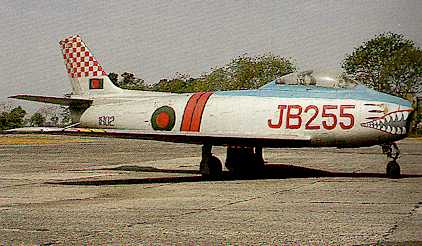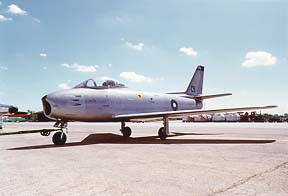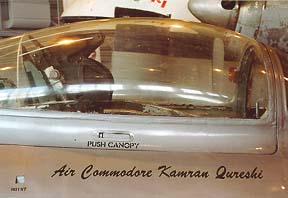| Pakistan Air Force Base Masroor And Senior Base Commanders Join The New P.A.F Based EMAIL Service Live News And Buy Online Books
|
|
F-86 Sabre: |
||||
 This North American Sabre is now in the museum at Dhaka |
History of PAF Sabre starts after the Korean war, when USAF realized Mig-15 was much better fighter and Sabre
needed much work on it,specially rate of climb. F-86Fm the day fighter variant which pakistan acquired embodied a much improved airframe. Combat experience also revealed a need for enhanced manoeuvrability, resulting in the development of the so called '6-3' wing with leading edge slats removed. With this modification installed, the Sabre was able to out-turn a Mig-15 and its high altitude/high Mach number manoeuvrability was considerably enhanced. The F-86 was powered by the J47-GE-27 engine rated at 5,910lb thrust, a 13 per cent improvement on A and E models. This resulted in greater speeds but a significantly improved rate of climb - in the order of 25 per cent at sea level - although this was still slightly inferior to the Mig-15. The final varint of F series, was the F-86F-F40. It had a curious mix of wing features. In order to restore the previous low speed docility and reduce the stalling speed, the leading edge slats were reinstated and each wing tip extended by 12 inches, resulting in a an overall wing span of 39ft 1.4 in and wing area increased to 313.4sq ft. The result was a stalling speed some 17 knots below that of the F-86F with '6-3' wing. |
|||
|
Specifications |
 Canadair Sabre #1815 returns to Canada Rolling a gleaming, newly painted Sabre Jet into a hangar for the first time is a sight everyone will remember but very few will ever experience. Four hundred guests assembled at the Western Canada Aviation Museum (WCAM) in Winnipeg on 8 August 1997 for just that experience. The museum was about to welcome Canada Sabre #1815; the last Sabre ever built in Canada, into its already impressive aircraft collection. The story actually began a number of years ago when the WCAM sent a letter to the Pakistan Air Force (PAF) inquiring about the possibility of acquiring a Sabre that was about to be retired from the PAFís active service list. Built in Canada, the Sabre represented the leading edge of modern jet technology in the 1950ís and as a result served in Air Forces all over the world right up to the 1970s. Not receiving a reply to the request, the WCAM went about its business until 1996 when the PAFís Air Commodore Kamran Qureshi contacted the WCAM to see when they were coming to get their airplane! With the wheels now in motion and with the help of 435 Sqn, the museum was able to retrieve the Sabre in May of 1996. Tragically, the very helpful and generous Air Commodore died in a drowning accident within hours of seeing the Sabre off to its new home. |
|||
 Back at the museum, preparations were being made to restore Sabre #1815 to its former condition. The decision was made to honour Air Commodore Qureshi by painting the Sabre in PAF colours and to add the Air Commodoreís name on the rim of the cockpit. Winnipeg 402 Sqn took on the task of restoring the body of the aircraft and Air Canada donated the time and skill to paint and apply the markings. On 8 August the Sabre was ready and the WCAMís guests gathered in the hangar to hear fascinating speeches by former RCAF Sabre pilots Andy MacKenzie, Syd Burrows, and Jim Pugh. Also providing welcoming remarks were Pakistan delegate Dr. Khalique Ahmed, MP John Harvard. WCAM President Bill Tweed and Executive Director George Elliot. As Jim Pugh raised his champagne glass in salute, the hangar doors opened and the Sabre moved forward in to the Museum to the strains of the Air Force March past. It was a very dramatic and touching moment that brought some to the point of tears. The Sabre now has a place of honour in the Western Canada Aviation Museumís permanent collection and can be seen by the public. Me At |
||||